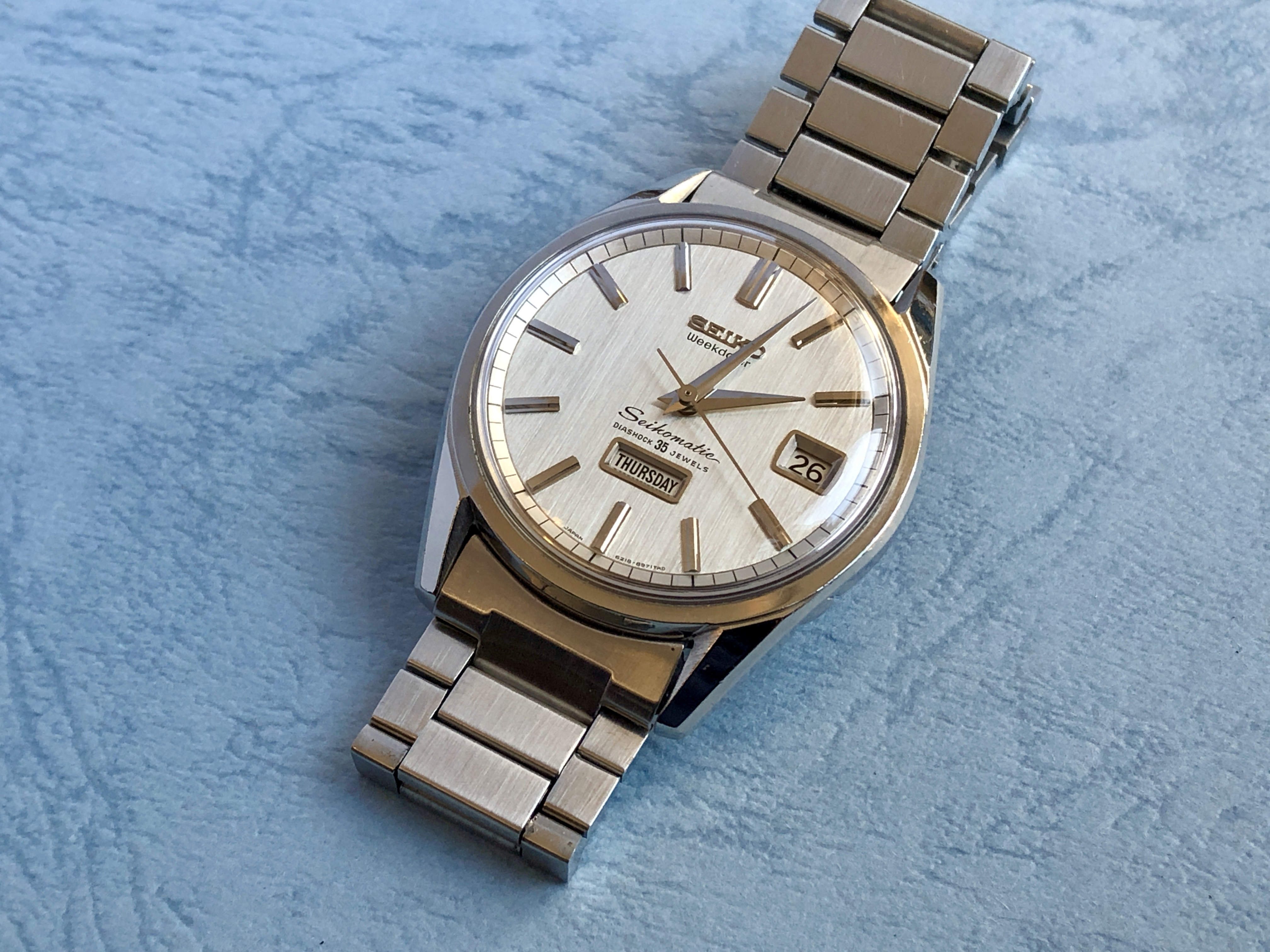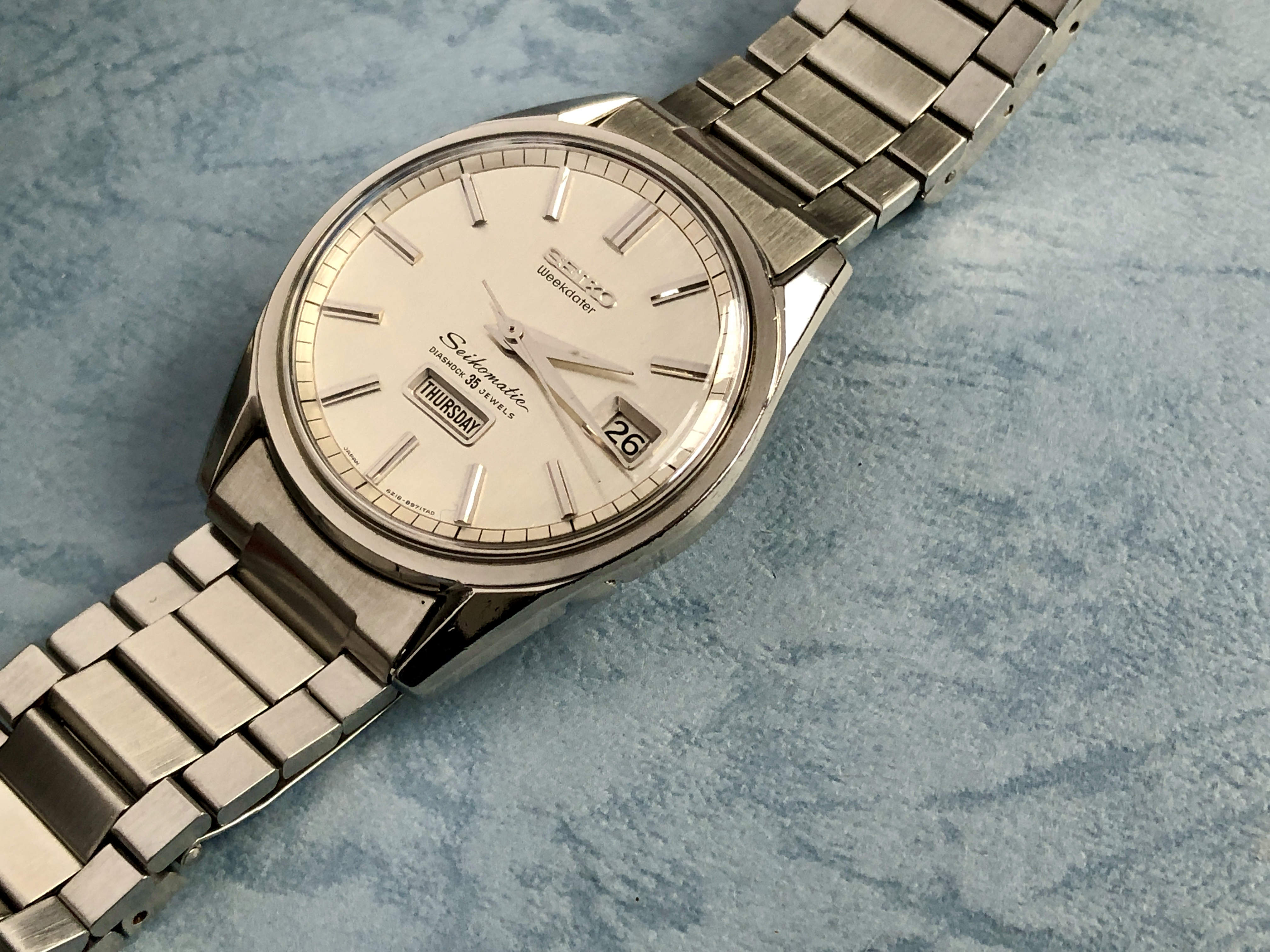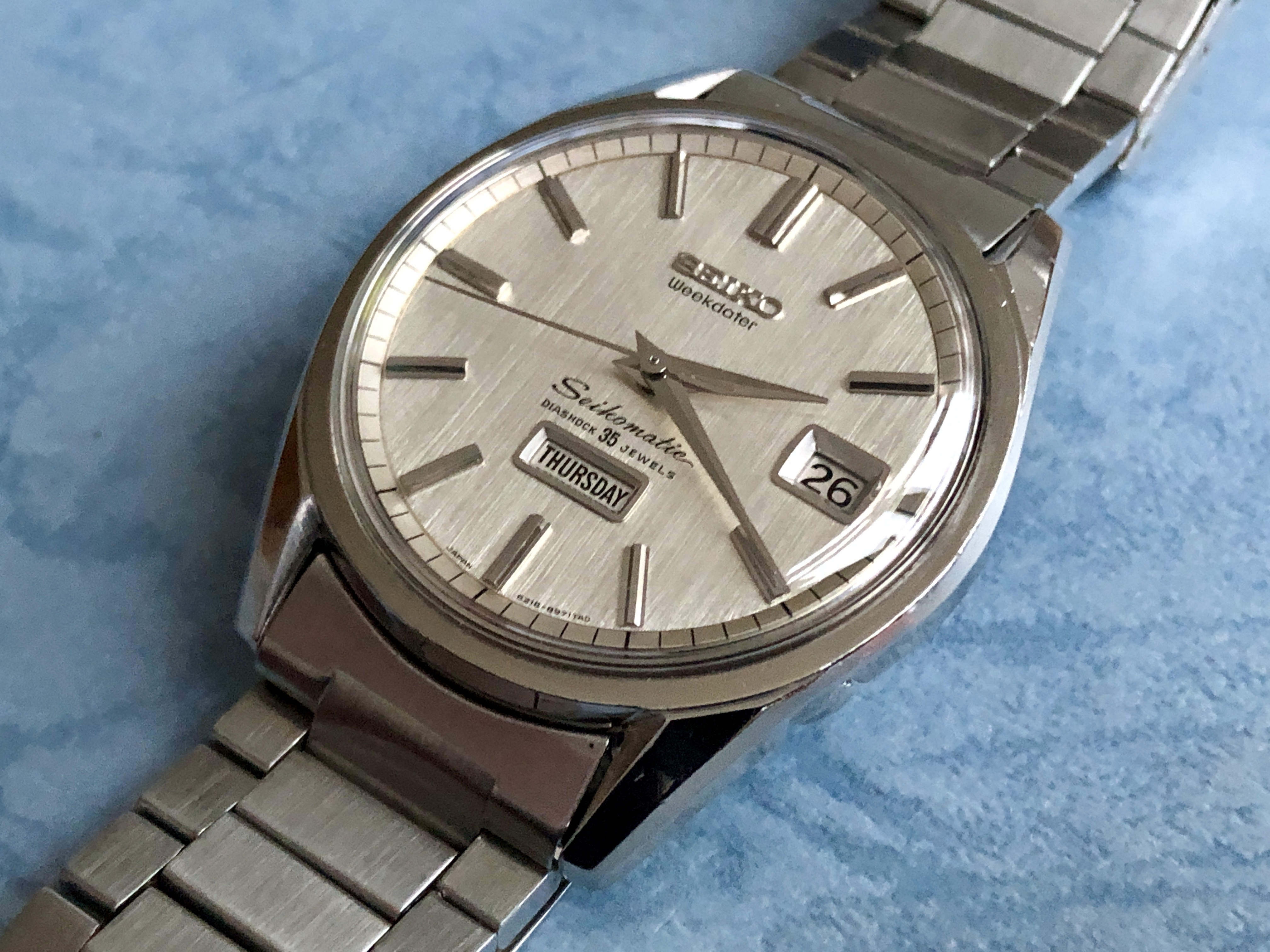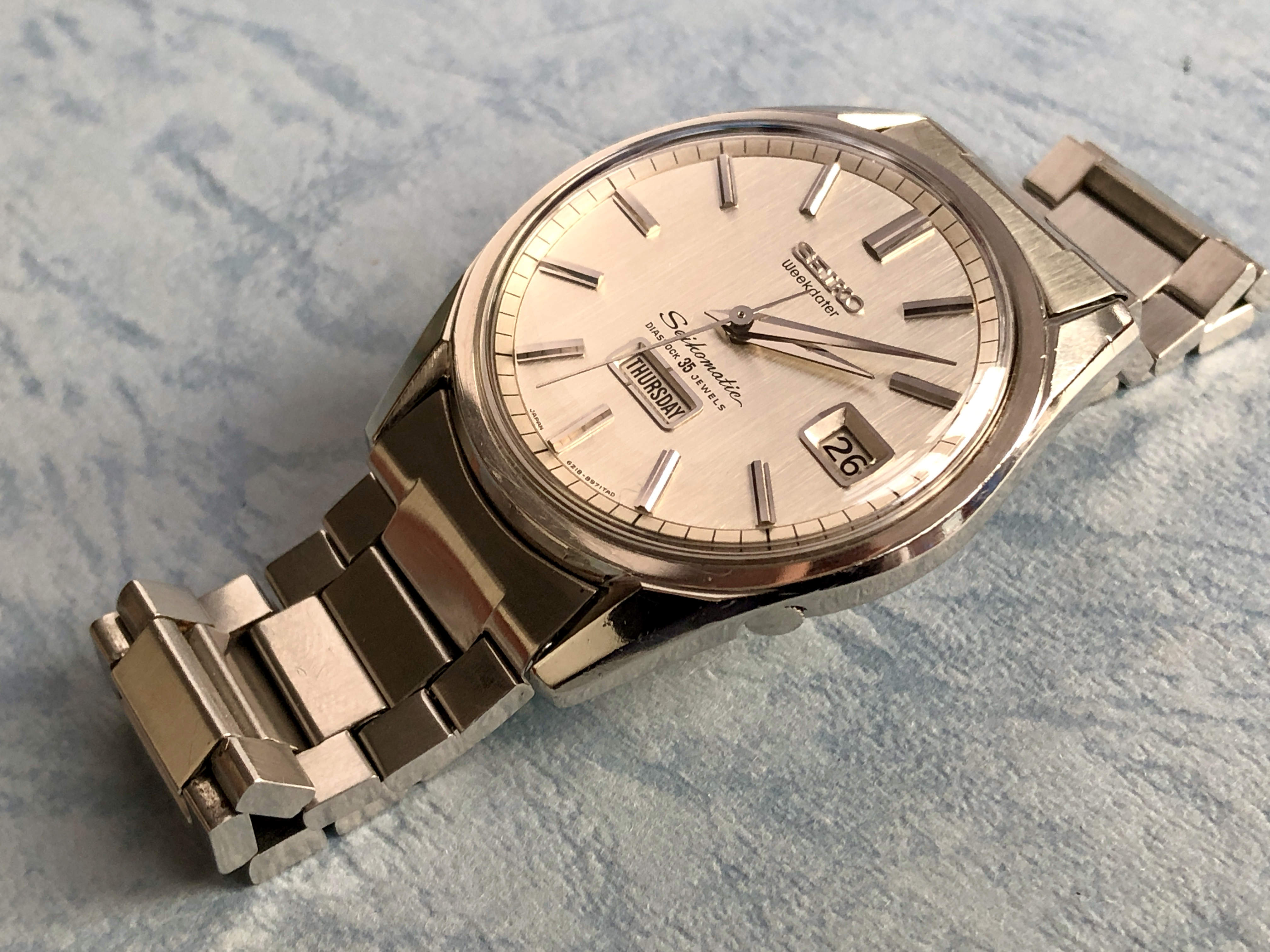
Seikomatic Weekdater 6218-8971 (Sold)
€ 445.00
Sold out
| About | Details | and then some |
|---|---|---|
| Manufacture | Seiko | Seikomatic |
| Model reference | Weekdater | 6218-8971 |
| Movement | Automatic | 18.000 bph |
| Caliber | 6218 | 8971 |
| Dial | Silver linen | Onyx inlays |
| Case | 37x42x11mm | Steel |
| Lugs | 19mm | |
| Bracelet | Original | 17,5cm - 19cm with extender |
| Crystal serial # | Unknown | Sapphire |
| Timegrapher | Amplitude 175, Beat error: 0,6ms | Accuracy:+10/-10spd |
| Jewels | 9 | |
| Serial # | 54xxxx | Production: 1965-04 |
| Condition | Excellent | |
| Service | NOS Crystal | |
| Box & Papers | No box | No papers |
This particular watch with a bold silver linen dial is fitted with polished applied markers with great detailing, and framed with a raised chapter ring - as most of the 62 series had. The framed date window is at three, the weekdater window at six. The mirror finished hour and minute hands are dauphine style for precison and legibility. With no separate bezel, the case has a thin profile with long lugs, giving it more presence on the wrist. And finally, the hacking 6218 offers quick-setting for the date, and a semi-quickset day, meaning you have to go to and fro between 9PM and 3AM to switch it, but hey, you cannot have it all... this is vintage.
Luxury in the 1960s
The first Seikomatic appeared in 1960, austere in design and function, but providing the starting point for a luxury product line that culminated into the early Grand Seiko. Features included waterproof cases, more or less mysterious complications like calendar, slimdate, selfdater and of course an automatic movement fitted with the brilliant magic lever invention, which uses pawls (consider them paws actually) rather than direct gearing between the oscillating rotor and the barrel. This helps isolate the gear train from shocks. This Seiko invention from 1959 improved winding efficiency, by transferring all oscillating movements of the moving weight - both clockwise and counterclockwise - to the main spring thereby reducing the time needed to fully wind the spring.
That first Seikomatic with the automatic 603 calibre (renamed the 6201), had a 27.6mm diameter movement running at 18000 bph. There were 17, 20 or 30 jewel variants. The mentioned date complication first appeared in the 24 jewel 394 Seikomatic Selfdater of 1962, later renamed as caliber 6205. That in turn evolved into the majestic 39 jewel 395 Self Dater 50 Proof of 1963.
From 1963 through 1967, Seiko released a number of automatic Seikomatic Selfdaters and Weekdaters. The weekdaters used the 400/6206 movement and evolved into the first chronometer Grand Seikos.
The first business man’s watch
In 1964/5 a second product line of Seikomatics joined the esthetics of the 62 series, but it was fitted with base caliber 83. Here the number of jewels from first comer 8306 seems to have been reduced to 27 in caliber 8346A as a cost reduction measure and to promote the product line to the young business man at a lower price point. Additionaly, it seems to have been good marketing to adjust the product branding to that Business nomenclature. Business-A was probably indicating an accuracy rating, but it was also used for the front loading 8306.. which featured 30 jewels. Front loading is collector’s slang for a monococ case design that would force the watchmaker to remove the crystal first in order to lift the movement out of the solid steel block. For everyone’s convenience it was even engraved with One Piece Case on the back.
Rather than the magic lever used in the automatic only 62 caliber, this winding mechanism incorporated the very practical and effective inversion roller system that allowed the watch to be manually wound via the crown.
Nevertheless, at the time of its launch in 1964 one other Seikomatic Weekdater became the bee’s knees of the automatic line-up, it was the hacking calibre 6218-8971 with 35 jewel, running at 18,000bph. Styling differences can be easily seen on the dial design, the presence or absence of the (applied) Gyro symbol or the little star just above the six o'clock marker or the framed-unframed weekdate window. Generally speaking however this Seikomatic Weekdater was already Grand Seiko material. It could be comfortably compared to the 57GS manual wind Self-Dater of 1963, and was well before the launch of the first automatic 62GS in 1967.
As mentioned the 6218 automatic is integral to the 62xx line-up with other highlights like Seiko’s 6217 World Time and their first dive watch the 62MAS. The excessive 35-jewel count of the 6218, and likewise that of the 57GS and 62GS, are all examples of the solution to the datewheel ‘shake& fall problem’. Below the date wheel three jewels were added to keep it balanced and stabilized.
According to Seiko design esthetics still seen today in dive watches or Alpinists, a variety of designs were engraved or stamped on the caseback, anything from sealions, seahorses, dolphins, olympic flames to crowns! The early engraved models of course were prone to fading and sometimes almost noting remains. The model 6218 usually has a crown and dolphin on the back.
The other, mechanically less endowed Seikomatics, even though not always named thus, were the Business Weekdaters with caliber 6206 or 8346 and especially the Sea Lion Weekdater – this one featuring a press-fit rather than a screw-down case back. These watches are still quality watches but are merely produced in a very cost-efficient manner, the Weekdater complication was even dropped in later versions.
As demonstrated above, by May 1964 the 6206 was stripped down to 26 jewels and its production simplified. It was made to be an affordable watch for the normal man, the train bound commuter in Japanese society during the mid-60s.
With this in mind the watch was made until February 1967, making the 6206 one of Seiko’s better known movements. The 6206 of course represented a significant price cut to JPY 12,500 from the JPY 15,000 of the 400 series, together with the Marvel it is probably the one with the most versions. One of these is the rare charcoal sunburst Business Diashock, which has omitted the weekdater dial text.
The 6206 caliber was produced in both A and B variants, with 6206B introduced in August 1965. The main change - other than those mentioned already - seems to be better efficiency in the day wheel function. As usual, there is both SS and goldplated cases. These also come with a number of different outer bezels both plain and more elaborate with fluted design. Most however have plain bezels.
Dials can be seen in four types: half sized markers with no inner bezel, long markers with minute graded inner bezel and the blocky markers on the crosshair dial. The fourth one is a very rare type with square markers at 3, 6, 9 and 12 and a graded dial. Dials exist in white, black and silver with a number of surface treatments. The day wheel is one langauge only in English or Kanji with a blue Saturday and a red Sunday. On the dial it can be read in both framed and unframed versions, possibly with the framed version only with 6206B calibers. As mentioned earlier, branding changed from the cursive Seikomatic script and the Seikomatic logo to the printed Seikomatic text with the applied Seiko logo, in fact much more changed on the dial but it can be hard to track all revisions. One small example is the change from October to December 1964, the Gyro symbol was removed, as was the little star above the six. Apparently Seiko no longer felt any need to indicate appliqué dial with the star, or automatic with the gyro/rotor symbol. It does lead to a cleaner dial design, but maybe some of the old school charm is lost in the process?
There is no doubt by now that the 6218 caliber has planted its flag on top of Mount Fuji with its greater heft and the screw down case back with dolphin and crown emblem. But in essence, it differs only through its finer regulation capabilities and its seconds setting function. The elevated jewel count indicated on the dial just providing a solution to the day-date wheel stability issues of the 6206.
Seikomatic's pinnacle
Over all, the third digit progression from 0, 1, to 4 noted in these caliber indications would appear to be a quality indication, meaning that the Grand Seiko 6245 or 6246 are somehow merely a small step up from the 6218 Seikomatic. However, the 6245 is spectacular in the design and finishing of the case, a sparkling dial and a notably higher level movement. The essential mechanical improvements are an elevated beat rate of 19800 bph, a rack and pinion fine adjustment regulation and jeweled barrel arbor holes in the main plate.
Then there is the unmentioned Seikomatic 6216-9000. In every respect this watch is in fact a 62GS. Its movement is identical, design and finishing are to the same high standard, and the dial may be even more charismatic. The 6217 mentioned earlier does not compete in this esthetically.
What the 6216 lacks however on its part is any assertion of chronometer status but also, more importantly, the Grand Seiko branding. In 1966 the Seikomatic 6216-9000 cost 23,000 Yen, yet the Grand Seiko 6246-9000 which in large part is the same watch, would have set you back 38,000 Yen. Of course, now you will have to pay vintage Grand Seiko money to acquire a good specimen.










